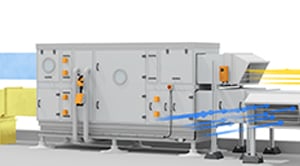Focus on Indoor Air Quality
Indoor air quality (IAQ) and its effect on occupant well-being and comfort are essential. Many issues such as sick building syndrome, indoor air quality thermal comfort, visual comfort, and acoustic comfort are a part of the indoor environment. Good indoor air quality requires attention to the building's HVAC system, measure and monitoring, healthy indoor air, air filtration, and pollutant source management. Some good practices in these areas have also been highlighted.
Essential parameters such as C02, humidity, temperature, and VOC concentrations are sometimes not measured, controlled, or displayed. Measuring and monitoring indoor air quality parameters is the first step to maintaining healthy and comfortable building environments. Measurement leads to control, improvements in comfort, and gaining the ability to maintain healthy indoor air quality.
 Healthy Indoor Air
Healthy Indoor Air
For healthy indoor air, air enters a room, flows through the room, and then leaves. Ideally, fresh air flows from the bottom up and extracts directly from the room. Indoor air should not "swirl" through the room several times or become lodged. Correct design placement and alignment of air outlets can help avoid serious air distribution problems. Evaluate your building systems to ensure the indoor air meets the ASHRAE guidelines. ASHRAE Standard 170 is the guideline for proper pressurization in positive and negative pressurized spaces. Every HVAC system needs to be analyzed to ensure the appropriate measures are being taken to improve and maintain adequate ventilation and reduce virus transmission in the building.
 Air Filtration
Air Filtration
Many factors go into the quality of indoor air, proper filtration and airflow, the right amount of outside air, adequate temperature and humidity levels, and more. Air handling units are equipped with filters to prevent airborne particles from entering the supply air ducts. If the exhaust air is mixed back into the supply air, air contamination occurs. HEPA filter H13, according to EN1822:2009, prevents infectious microbes in the air. Replacing or cleaning clogged air filters is a critical maintenance task. It is essential to use pressure sensors and dynamic airflow measurements to monitor and maintain the filters. When contamination of the filter increases, the pressure drop across the filter also increases. Simultaneous measurement of the flow can determine filter replacement.
 Pollutant Source Management
Pollutant Source Management
The placement of furniture, equipment, or partitions that block supply or return registers can affect indoor air quality. HVAC systems can be the source of pollutants when ventilation air filters are dirty or microbial growth from stagnant water in drip pans or uncontrolled moisture inside of air ducts.
Indoor air quality is a shared responsibility. Besides what was previously addressed, some factors contributing to poor indoor air quality may originate from inadequate HVAC design, tenants and occupants with the materials they use, or the building's and individuals general housekeeping. For these reasons, indoor air quality is everyone's responsibility to maintain.


